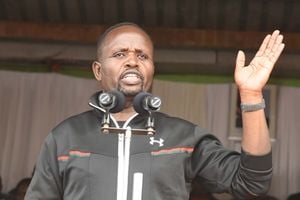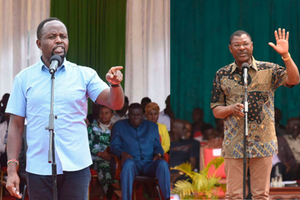
National Assembly Speaker Moses Wetang’ula (right) and Trans Nzoia Governor George Natembeya.
One step forward, two steps back, is usually the movement of human organisation. The tired Frenchmen observed during the revolutions that brought their country from feudalism to a republic that ‘the more things change, the more they remain the same.
It was an observation made in fatigue and restlessness occasioned with the gains turning into losses. It is with the same wariness and weariness that Kenyans are viewing the changes in the political scheme of things.
They are smelling and seeing the return of the 1980s creeping out of the grave complete with the forgotten tribal point men of yore.
Those tribal key men were the extensions of the President’s roots in every region. They were the ones who decided who progresses in their turf and who drops out. Those were the Moses Mudavadis, the Shariff Nassirs, the Joseph Kamothos, and the Mulu Mutisyas of the time.
All these are back in different attires but with the same blessings and shrillness in the support of the presidency.
The new wine is slowly be- ing poured into old wineskins. Political analysts say loyal students of the former Kanu engineer seem to wish to turn the present tide back to the old system.
In a move that mirrors Moi’s political schemes, a strategy that saw him remain in power for 24 years, the Kenya Kwanza coalition appears to be following the same path with plans to turn the United Democratic Alliance (UDA) into a behemoth ahead of the 2027 General Election.
President Moi rode on a single party State for the first 14 years of his regime where Kanu was the government and the government was Kanu. There was no thin line between the government and the ruling party; it was impossible to know when the President was talking as the party leader or as the country’s chief executive.
Expulsion from the party meant dismissal from the government.
This sad state of affairs continued until the birth of multipartyism in 1992. With one of his levers on power nipped, Moi turned to tribal point men to keep his political nemesis in check, thriving on the infamous divide-and-rule strategy to maintain political stranglehold in the country.
Today, more than 20 years since Moi left power, President Ruto seems to be using his one-time political mentor’s script to put his rivals in check. The ruling party is wooing young, energetic leaders to checkmate legacy leaders. Political temperatures have already started rising in Western Kenya and the vote-rich Mt Kenya region.
In Central, a silent supremacy battle has been going on between Deputy President Rigathi Gachagua and Kiharu MP Ndindi Nyoro. The two politicians have been shadow-boxing for control of the region’s political soul and in January, the fight threatened to explode after some 18 UDA endorsed the second term MP to succeed President Ruto in 2032 and possibly be his running mate in 2027.
As the senior most leader in the region by virtue of his position as the country’s second-in-command, Gachagua has not been having it easy in his quest to be recognised as the region’s kingpin.
Nyoro, who appears to be UDA’s blue-eyed political boy, has been traversing not only the region but also the country in the name of presiding over launch of education programmes as he popularises his political stature.
Political pundits opine that the tussle between the two is a well-choreographed scheme to deny the region a de facto supremo. Mt Kenya is crucial for the President’s re-election arithmetic with the region giving him more than a third of his 7.1 million votes in the 2022 elections.
Dr Ruto swept to victory with the 10 Mt Kenya counties delivering 2,938, 309 votes against 1.6 million votes contributed by seven North Rift counties.
A similar political fight is unfolding in Western, pitting Ford-Kenya leader and National Assembly Speaker Moses Wetang’ula against Trans Nzoia Governor George Natembeya.
The two have in recent weeks engaged in heated confrontations, flexing their political muscles in the fight for the control of the region’s two million-plus votes. Wetang’ula has been positioning himself as the de facto leader of Western but Natembeya has taken the 67-year-old head-on with a new movement christened ‘Tawe’, aimed at liberating the region from “politics of poverty”.
Third Way Alliance party leader Dr Ekuru Aukot told The Weekly Review that the political supremacy battles don’t surprise him.
“Remember those in charge of the government are control freaks right from the top. They want to be seen as people controlling certain regions using protégés,” he said.
He said Nyoro is turning out to be President Ruto’s sycophant as he allegedly endears himself for a possible choice of a deputy president in 2027.
“It is clear that in Western, Natembeya has been given a brief to deal with Wetang’ula because his agenda is Wetang’ula every time. Somebody somewhere is basically benefiting from the shouting,” he said.
Political commentator Dr Samuel Okuro spoke of the possibility of a higher hidden hand in the political upheavals in the two major regions.
He said in the case of Wetang’ula, there could be a hidden hand because of the pressure to fold affiliate parties to join UDA where he has been one of the political players who have been opposed to the merger plans.
“This may be a scheme to box him in to see the bigger picture that should he not toe the line then even more can be done to him politically,” said Dr Okuro.
“Western Kenya is one the biggest winners in Dr Ruto’s government and how to maintain that depends on who brings the highest number of votes.
That can be another factor that people are realigning themselves so that they can benefit should President Ruto form the next government,” he added. Political analyst Javas Bigambo said it could be minimalistic in perspective to conclude there is someone fighting Wetang’ula or Gachagua.
He said that being that nature abhors a vacuum and with Prime Cabinet Secretary Musalia Mudavadi technically neutralised by being in the Cabinet and Wetang’ula being speaker, there is a clear hole in terms of political leadership in Western.
Further, other governors have pigeon-holed themselves into their specific counties rather than raise their heads above the water, setting the stage for Natembeya to shine.
Bigambo argued that by Wetang’ula intimating that there could be external hands elevating, supporting or even financing Natembeya, he only wants to send fear across his support base that he is silently being fought within Kenya Kwanza.
“If Dr Ruto, if intimation by Wetang’ula is anything to go by, wanted to fight him, actually he would not have to fight much. He would just engineer his ouster from the Speaker’s position and render him politically beaten,” said Bigambo.
“The mistake Wetang’ula can make is to intimate he is being fought by Kenya Kwanza for refusing to fold his party,” he added. In Ukambani, Mwala MP Vincent Kawaya is the UDA leading light in a region dominated by Wiper party leader Kalonzo Musyoka.
In April 2023, the UDA MP was unveiled as the party’s point man in the region. The Kenya Kwanza coalition is also banking on former Machakos Senator Johnson Muthama, and Maendeleo Chap Chap leader Dr Alfred Mutua in its bid to penetrate into the region that overwhelmingly voted for the Azimio la Umoja One Kenya Coalition.
In the August 2022 poll, Azimio received 769,985 votes from the three Ukambani counties as well as bagging the bulk of the seats while Kenya Kwanza got 250,188 votes.
In Coast, the ruling coalition is betting on former Kilifi Governor and Pamoja African Alliance leader Amason Kingi. Kingi was rewarded with the plum Senate Speaker’s position after defecting to the Kenya Kwanza Alliance in the run-up to the 2022 elections.
Other defectors from the region, such as former Malindi MP Aisha Jumwa and exKwale Governor Salim Mvurya, also got appointed to the Cabinet in a bid to appease voters. The President is using Kingi and Jumwa to counter Hassan Joho’s influence in a region that has traditionally backed the opposition.
Dr Ruto saw his tally shoot up at the Coast from the 287,066 recorded in 2017 (with Uhuru Kenyatta) to 324,353 as Odinga’s votes dropped from 801,031 in 2017 to 648,834.
The power plan extends to Northern Kenya where the ruling coalition has wrestled most governors into its orbit. The region’s leading lights are Defence Cabinet Secretary Aden Duale, National Intelligence Service Director-General Noordin Haji, and Deputy Inspector-General of Police Noor Gabow.
Earlier this month, UDA caused an uproar when it appointed two top State officials to run the party’s grassroots elections later this month. Kenya Revenue Authority (KRA) board chairperson Anthony Mwaura was appointed to head the party’s National Elections Board while Joy Mdivo, Kenya Power board chairperson, will shepherd the Electoral Disputes Resolution Committee.
ODM demanded the resignation of the two. “We are staring at the return of the party state system last seen in the 1980s where party leaders and public servants were one and the same thing. What followed was a youth wing with watchdog or surveillance responsibilities over the entire nation,” said ODM Secretary-General and Nairobi Senator Edwin Sifuna.
“We take the position that this development is wrong. It is a recipe for chaos, dictatorship and partisanship in the management of public affairs,” he added. Analysts believe UDA is trying to create a political behemoth similar to Chama Cha Mapinduzi in Tanzania, the African National Congress of South Africa or the Chinese Communist Party (CCP).
CCP has maintained political domination in China since 1949 as the sole ruling party, running roost in the Cabinet, army and Parliament, boosting more than 98 million members as of 2023. In Kenya, calls for changes on the Constitution to allow President Ruto to stay in power beyond his two limits – if successful in 2027 – are gaining momentum.
“Let’s change the Constitution, what’s the problem?” posed Pokot South MP David Pkosing last week. Fafi MP Salah Yakub had in 2022 said he would come up with a Bill to scrap the two-term-presidential limit and instead set the age limit for contesting for the same seat at 75.
The first term lawmaker argued that a presidential term should not be limited to only two terms, saying it denies performing leaders an opportunity to further develop the country.







